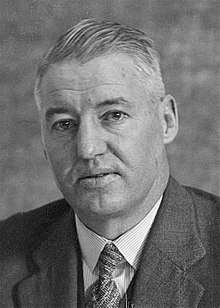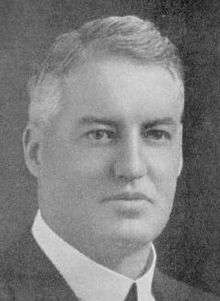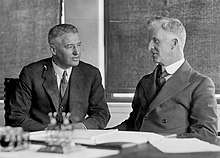Ted Theodore
| The Honourable Ted Theodore | |
|---|---|
 | |
| Premier of Queensland | |
|
In office 22 October 1919 – 26 February 1925 | |
| Governor |
Hamilton Goold-Adams Matthew Nathan |
| Preceded by | T. J. Ryan |
| Succeeded by | William Gillies |
| Treasurer of Australia | |
|
In office 22 October 1929 – 8 July 1930 | |
| Prime Minister | James Scullin |
| Preceded by | Dr Earle Page |
| Succeeded by | James Scullin |
|
In office 29 January 1931 – 5 January 1932 | |
| Prime Minister | James Scullin |
| Preceded by | James Scullin |
| Succeeded by | Joseph Lyons |
| Treasurer of Queensland | |
|
In office 1 June 1915 – 9 March 1920 | |
| Premier |
T. J. Ryan Himself |
| Preceded by | Walter Barnes |
| Succeeded by | John Fihelly |
|
In office 8 February 1922 – 26 February 1925 | |
| Premier | Himself |
| Preceded by | John Fihelly |
| Succeeded by | William Gillies |
| Member of the Australian House of Representatives | |
|
In office 18 January 1927 – 19 December 1931 | |
| Preceded by | Walter Barnes |
| Succeeded by | Sol Rosevear |
| Constituency | Dalley |
| Member of the Queensland Legislative Assembly | |
|
In office 27 April 1912 – 22 September 1925 | |
| Preceded by | New seat |
| Succeeded by | John O'Keefe |
| Constituency | Woothakata |
|
In office 2 October 1909 – 27 April 1912 | |
| Preceded by | Michael Woods |
| Succeeded by | Seat abolished |
| Constituency | Chillagoe |
| Personal details | |
| Born |
Edward Granville Theodore 29 December 1884 Adelaide, South Australia, Australia |
| Died |
9 February 1950 (aged 65) Edgecliff, New South Wales, Australia |
| Resting place | South Head Cemetery |
| Political party | Labor |
| Spouse(s) |
Esther Mahoney (m. 1909) |
| Relations | Stephen Theodore (brother) |
Edward Granville Theodore (29 December 1884 – 9 February 1950), nicknamed Red Ted, was an Australian politician who served as Premier of Queensland from 1919 to 1925, as leader of the state Labor Party. He later entered federal politics, serving as Treasurer in the Labor Scullin Government.
Theodore was born in Adelaide, the son of a Romanian immigrant. He left school at the age of 12, and spent the next decade working his way around the country. He arrived in Queensland in 1906, and soon became involved in the labour movement. Theodore was elected to the Queensland Legislative Assembly in 1909, aged just 24. He was also elected state president of the Australian Workers' Union in 1913. Theodore became Treasurer of Queensland following Labor's victory at the 1915 state election.
In 1919, Theodore succeeded T. J. Ryan as premier. His government pursued various interventionist economic policies, establishing a number of state-run enterprises and introducing new competition and labour market regulations. A notable constitutional reform was the abolition of the Queensland Legislative Council in 1922; Queensland remains the only Australian state with no upper house in its parliament. Theodore was popular among the general public, and won two state elections (1920 and 1923) before resigning in 1925 to enter federal politics. He was defeated at his first attempt, but two years won a by-election for a seat in Sydney.
In 1929, Theodore was elected deputy leader to James Scullin. He became Treasurer after the 1929 election, but resigned after less than a year amid accusations of corruption. Theodore returned as a Treasurer in early 1931, and served until the government's landslide defeat at the 1931 election, where he lost his own seat. He had little success in combating the Great Depression, and disputes over economic policy led to a party split and several defections to Lang Labor and the United Australia Party. Theodore was only 47 when he left politics, and went on to have a successful business career as a partner of Frank Packer.
Early life
Theodore was born on 29 December 1884 in Port Adelaide, South Australia, the second of six children born to Annie (née Tanner) and Basil Stephen Theodore.[1] His parents had met in 1882, on the passage from England to Australia. After arriving in Fremantle, Western Australia, they initially went their separate ways; they kept in touch by letter, however, and by the end of the year had married in Perth. They subsequently moved to Adelaide, where their first son Stephen was born the following year.[2]
Theodore’s father, originally named Vasile Teodorescu, was born in Galați, Romania, into a well-to-do family connected with the Romanian nobility. He and his brother travelled to London in their youth, where they learned English. His parents had intended that he follow his father into the Romanian Orthodox priesthood, but he quit divinity school to join the British Merchant Navy.[1] Theodore’s mother was born in Manchester, England, and descended from Irish immigrants. Her father died when she was an infant, and she was sent to work in the Lancashire cotton mills. When her mother died, she accepted an invitation to join her step-brother Tom Harrison (an ex-convict) at his farm in Greenough, Western Australia; however, she stayed there only a few months before returning to Perth to marry.[2]
Theodore was educated at Lefevre Peninsula Catholic and Aldgate State schools in Adelaide, but left school at 12 to work on the Adelaide docks. In 1900, aged 16, he left for the goldfields of Western Australia, working as a labourer at Lennonville and Peak Hill. He then joined a guano mining crew on the Houtman Abrolhos, where he acquired his lifelong love of fishing.[3] After a while, Theodore returned to the mainland and worked as a gold miner at Day Dawn and Kalgoorlie. He went back to Adelaide for Christmas 1902, and then joined his father on an unsuccessful prospecting expedition to Leigh Creek and Bundaleer, where they had hoped to find copper. Later in 1903, Theodore got his first experience in industrial relations, helping negotiate a wage increase for miners at Arltunga.[4] He then decided to try his luck at Broken Hill, New South Wales. In 1906 he left for Cairns, Queensland where he prospected for tin in the Chillagoe area and worked in the Vulcan Mine in Irvinebank. It was among the unorganised workers of Stannary Hills and Irvinebank that the Amalgamated Workers' Association of North Queensland was born.
Queensland politics

Theodore founded the Amalgamated Workers' Association with Bill McCormack. This union used the process and principle of amalgamation to unify with other unions until it became Australia's largest union, the Australian Workers' Union (AWU). Theodore became Queensland state president of the AWU in 1913. Meanwhile, he had been elected to the Legislative Assembly of Queensland in Woothakata from 1909 to 1912 for the Australian Labor Party and subsequently from 1912 to 1925 in Chillagoe (the seat of Woothakata renamed).[5][6] His position in the AWU made him a power in the Parliamentary Labor Party, and when Labor won a majority in the Assembly for the first time in 1915, he became Treasurer and Secretary for Public Works in the government of T. J. Ryan.
In 1919 Ryan resigned and Theodore succeeded him as premier of what was then Australia's only Labor state government, following the great split in the Labor Party over the issue of conscription in World War I. He was a popular and successful Premier, and soon began to be talked about as a possible federal Labor leader. Important educational measures were implemented, which benefited the handicapped and isolated, adult franchise in local government was introduced, and the upper house of Parliament abolished. Workers benefited from the introduction of a compulsory unemployment scheme, changes in the Safety and Accommodation Acts, and the Profiteering Prevention Act. Improvements in housing were also secured through amendments to the Savings Bank Act, the Workers' Homes Act, and the Fair Rents Act. Agriculture also received much attention through measures like the Agricultural Education Act, the Irrigation Act, the Main Roads Act, and the establishment of an Agricultural Bank, a cold store, a state cannery, a Cheese Pool, and a wheat board. Orderly marketing and controls on price fluctuations were also carried out to develop agriculture, while the Theodore Government also involved itself in the marketing of Queensland fruit produce.[7]
In 1925, Theodore resigned as Premier and stood for the Queensland seat of Herbert in the federal election, but was unexpectedly defeated by Lewis Nott by 268 votes.[8]
Federal politics

Theodore was elected to the House of Representatives for the seat of Dalley in Sydney at a 1927 by-election. His status as an outsider in Sydney Labor politics was a permanent problem for him, but he soon made his mark in federal Parliament. In 1929 he became Deputy Leader of the Labor Party under James Scullin. In October 1929 Scullin defeated the conservative government of Stanley Bruce and became Prime Minister, while Theodore became Treasurer.
Two days after the Scullin government was sworn in, the US stock market crashed. The effects of the Great Depression were soon felt in Australia, and the Scullin government, like others, was hard pressed to deal with mounting unemployment and the collapse of world trade, on which Australia's export-based economy depended. Theodore, an early advocate of Keynesian economics, favoured deficit spending to rejuvenate the economy. However, Works and Railways Minister Joseph Lyons and Trade Minister James Fenton supported a more traditional, deflationary approach.
Meanwhile, a conservative government had taken power in Queensland, and appointed a Royal Commission to investigate Theodore's financial dealings as Premier. The Commission found that Theodore and another former Queensland Premier William McCormack, had corruptly profited by authorising the purchase by the state of a copper mine at Mungana while concealing the fact that they had a financial interest in the mine, which furthermore was not economically viable. In July 1930 the "Mungana affair" forced Theodore's resignation.[9][10]
Without Theodore's leadership and financial skills, the Scullin government drifted into deeper crisis. When it became apparent that the Queensland government did not intend charging Theodore with any offence, Scullin re-appointed him as Treasurer, in January 1931. Lyons and Fenton felt that Scullin should have waited until Theodore had been formally cleared, and resigned from cabinet in protest. Two months later, they and three of their supporters crossed the floor to the non-Labor opposition, and eventually joined forces with the Nationalists to form the United Australia Party, led by Lyons.
The Depression

During 1931 Theodore faced the greatest economic crisis in Australian history. The government imported an advisor from the Bank of England, Dr Otto Niemeyer, who recommended an "orthodox" solution, including sharp reductions in government spending such as pensions and unemployment benefits. The radical Premier of New South Wales, Jack Lang, on the other hand, campaigned for the repudiation of Australia's debt to bond-holders in London.
Theodore rejected both these alternatives and proposed instead an expansion of credit to farmers and small business, through the issue of "fiduciary notes" which could be redeemed after the Depression. His Fiduciary Notes Bill was denounced as financially unsound by orthodox economists and the banks. It was eventually defeated in the Senate, which was still controlled by the conservative opposition. Theodore has been described as a visionary proto-Keynesian for this proposal, although it cannot be known what effect his measures would have had on the Depression had the bill been passed.
In March 1931, Lang's supporters in Parliament deserted the main body of Labor. Combined with the defection of Lyons and his supporters a few weeks earlier, this cost Scullin his majority. In November, the UAP and Langites rose to defeat the government on a non-confidence motion, and an election was held in December. Theodore had no base of support in Sydney and he lost his seat to Lang candidate Sol Rosevear. This ended Theodore's political career, although during the 1930s several offers were made to him to return.
Later life

Theodore went into business, becoming a business partner of Frank Packer in gold-mining ventures in Fiji and other enterprises, making him a rich man. He was chairman of directors of Packer's press company, Australian Consolidated Press, and director of several other companies.
During World War II Theodore served the Curtin and Chifley governments as Director of the Allied Works Council, which was established to undertake works requested by Allied Forces in Australia during World War II.[11] After the war his health declined and he died of hypertensive cardiovascular disease on 9 February 1950 at his home Princeton at 282 New South Head Road, Edgecliff, Sydney. He was buried at South Head Cemetery on 11 February 1950 after a large funeral was held at St Mary's Cathedral, Sydney.[12]
Family
In 1909 Theodore married Esther Mahoney and they had four children. After Ted's death his son John assumed charge of the family's joint business interests with Frank Packer and he became the first managing director of Channel 9.
Assessment
The Mungana affair likely cost Theodore a chance to become prime minister, and would "irreparably taint his reputation during his lifetime and beyond". Historian Ross Fitzgerald has called him "the most talented Labor politician never to be prime minister of Australia", and noted that his admirers include Paul Keating, Bob Katter, and Jack Lang (his former opponent).[13]
Named in his honour
The following things were named after Thedore:
- Theodore, a town in the Shire of Banana [14]
- Electoral district of Theodore, an electorate in the Queensland Legislative Assembly created in the 2017 Queensland state electoral redistribution [15]
- Theodore, suburb of Canberra [16]
References
- 1 2 <Fitzgerald, Ross (1994). "Red Ted": The Life of E. G. Theodore. University of Queensland Press. p. 1. ISBN 9780702226496.
- 1 2 Fitzgerald (1994), p. 2.
- ↑ Young, Irwin (1971). Theodore: His Life and Times. Alpha Books. p. 8. ISBN 0855530642.
- ↑ Young (1971), p. 9.
- ↑ "Alphabetical Register of Members of the Legislative Assembly 1860–2012 and the Legislative Council 1860–1922" (PDF). Queensland Parliament. Archived (PDF) from the original on 31 October 2013. Retrieved 30 January 2014.
- ↑ "Representatives of Queensland State Electorates 1860–2012" (PDF). Queensland Parliament. Archived (PDF) from the original on 1 April 2015. Retrieved 30 January 2015.
- ↑ Ross McMullin, The Light on the Hill: The Australian Labor Party 1891–1991
- ↑ Farquharson, John. "Nott, Lewis Windermere (1886–1951)". Australian Dictionary of Biography. Australian National University. Archived from the original on 23 March 2007. Retrieved 18 August 2007.
- ↑ "Advertising". The Week. CIX, (2, 846). Queensland, Australia. 11 July 1930. p. 1. Retrieved 5 November 2017 – via National Library of Australia.
- ↑ "SEQUEL TO MUNGARA REPORT". Camperdown Chronicle. LVI, (4490). Victoria, Australia. 8 July 1930. p. 5. Retrieved 5 November 2017 – via National Library of Australia.
- ↑ "Allied Works Council (1942–1945)". Australian Science at Work. Australian Science and Technology Heritage Centre. Archived from the original on 27 September 2006. Retrieved 7 February 2007.
- ↑ "Family Notices". The Sydney Morning Herald (34, 989). New South Wales, Australia. 10 February 1950. p. 18. Retrieved 28 July 2016 – via National Library of Australia.
- ↑ Scandal that stole Red Ted's chance to tackle top job, The Australian, 13 April 2013.
- ↑ "Theodore - town in Shire of Banana (entry 34200)". Queensland Place Names. Queensland Government. Retrieved 30 October 2017.
- ↑ Queensland Redistribution Commission (26 May 2017). "Determination of Queensland's Legislative Assembly Electoral Districts" (PDF). Queensland Government Gazette. pp. 169, 173. Archived (PDF) from the original on 29 October 2017. Retrieved 29 October 2017.
- ↑ "Australia For Everyone: Canberra - The Names of Canberra". australiaforeveryone.com.au. Archived from the original on 13 March 2016. Retrieved 6 March 2018.
Further reading
| Wikimedia Commons has media related to Ted Theodore. |
- Red Ted: The Life of E. G. Theodore, Ross Fitzgerald, University of Queensland Press, 1994
- The Mungana Affair: State Mining and Political Corruption in the 1920s, K. H. Kennedy, University of Queensland Press, 1978
- Theodore: His Life and Times, Irwin Young, Alpha Books, 1971.
| Political offices | ||
|---|---|---|
| Preceded by T. J. Ryan |
Premier of Queensland 1919–1925 |
Succeeded by William Gillies |
| Preceded by Dr Earle Page |
Treasurer of Australia 1929–1930 |
Succeeded by James Scullin |
| Preceded by James Scullin |
Treasurer of Australia 1931–1932 |
Succeeded by Joseph Lyons |
| Parliament of Queensland | ||
| Preceded by Michael Woods |
Member for Woothakata 1909–1912 |
Succeeded by Abolished |
| Preceded by New Division |
Member for Chillagoe 1912–1925 |
Succeeded by John O'Keefe |
| Parliament of Australia | ||
| Preceded by William Mahony |
Member for Dalley 1927–1931 |
Succeeded by Sol Rosevear |
| Party political offices | ||
| Preceded by T. J. Ryan |
Leader of the Labor Party in Queensland 1919–1925 |
Succeeded by William Gillies |
| Preceded by Arthur Blakeley |
Deputy Leader of the Australian Labor Party 1929–1931 |
Succeeded by Frank Forde |